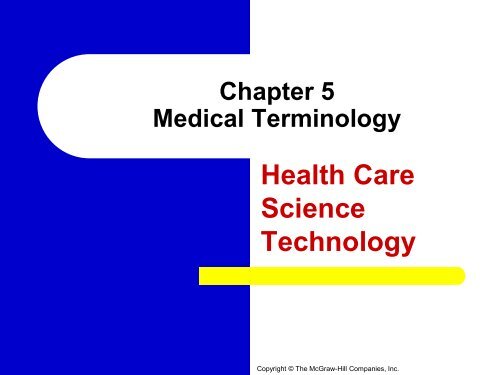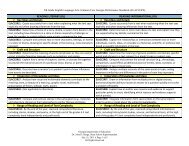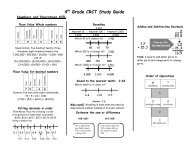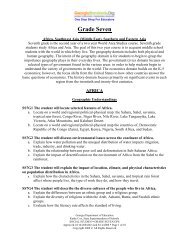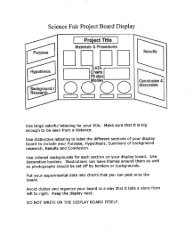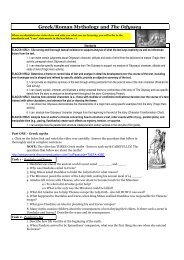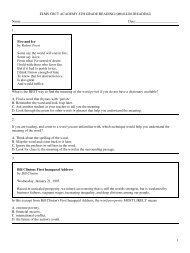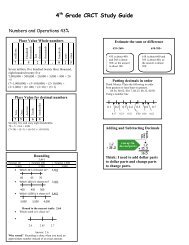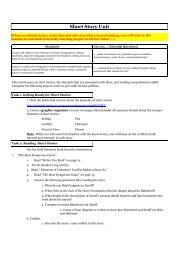Chapter 5 Medical Terminology
Chapter 5 Medical Terminology
Chapter 5 Medical Terminology
- No tags were found...
Create successful ePaper yourself
Turn your PDF publications into a flip-book with our unique Google optimized e-Paper software.
Objectives2• Identify the 4 medical technology wordparts.• Build and break apart medical terms tocreate or define medical terminology.• Know how to “read” medical terms.• Use the common medical terminologyfor each body system.• List common medical abbreviations.Copyright © The McGraw-Hill Companies, Inc. <strong>Chapter</strong> 5
Understanding <strong>Medical</strong><strong>Terminology</strong> 5-1• Using Word Parts to Build <strong>Medical</strong><strong>Terminology</strong>• Decoding <strong>Medical</strong> Terms3Copyright © The McGraw-Hill Companies, Inc. <strong>Chapter</strong> 5
Using Word Parts to Build <strong>Medical</strong><strong>Terminology</strong>• Word root (WR) – The basicmeaning of the medical term,usually from Latin or Greekwords.• Examples:– neur = nerve– cost = rib4Copyright © The McGraw-Hill Companies, Inc. <strong>Chapter</strong> 5
Using Word Parts to Build <strong>Medical</strong><strong>Terminology</strong> (cont.)• Combining form (CF) – Word rootplus a vowel, usually an “o”, tohelp in pronunciation.• Examples:– neur/o = nerve– cost/o = rib5Copyright © The McGraw-Hill Companies, Inc. <strong>Chapter</strong> 5
Using Word Parts to Build <strong>Medical</strong><strong>Terminology</strong> (cont.)• Prefix (P) – Attached to thebeginning of a word, to describe,modify, or limit. Not all medicalterms have prefixes.• Examples:– trans – across, through– intra – in, within– sub – less than, under7Copyright © The McGraw-Hill Companies, Inc. <strong>Chapter</strong> 5
Decoding <strong>Medical</strong> Terms• Start with the suffix (the word ending),and define the suffix.• Go to the prefix; define the prefix.• Then, go to the middle of the word;define the word root, combining form,or both if both exist in the same word.• Combine the definitions.8Copyright © The McGraw-Hill Companies, Inc. <strong>Chapter</strong> 5
Section 5-1Apply Your KnowledgeWhen defining a medical term,you should start with which part?Answer:When defining a medical term, youshould start with the suffix.9Copyright © The McGraw-Hill Companies, Inc. <strong>Chapter</strong> 5
Building <strong>Medical</strong> Terms 5-2• Compound Words10Copyright © The McGraw-Hill Companies, Inc. <strong>Chapter</strong> 5
Compound WordsPrefixWordRootSuffix11Copyright © The McGraw-Hill Companies, Inc. <strong>Chapter</strong> 5
Compound Words (cont.)• Combining Forms: Transneurocostal– Suffix - al = pertaining to– Prefix trans = across– Combining form neur/o = nerve– Word root cost = rib• Definition: Pertaining to across thenerves of the ribs.12Copyright © The McGraw-Hill Companies, Inc. <strong>Chapter</strong> 5
Section 5-2Apply Your KnowledgeIn compound words, what formsare used between word roots?Answer:13In compound words, combiningforms are used between wordroots.Copyright © The McGraw-Hill Companies, Inc. <strong>Chapter</strong> 5
Frequently Used Word Parts 5-3• Frequently Used Suffixes• Frequently Used Prefixes• Plural Forms• Commonly Used Word Roots• Descriptive Terms• Directional Terms• Word Parts for Colors14Copyright © The McGraw-Hill Companies, Inc. <strong>Chapter</strong> 5
Plural Forms• When a singular word ends in y, theplural is often formed by changing y to iand adding es.• When a singular word ends in a, add e toform the plural.• If a singular word ends in um, change theum to a to form the plural.15Copyright © The McGraw-Hill Companies, Inc. <strong>Chapter</strong> 5
Section 5-3Apply Your KnowledgeWhat is the plural form of each ofthe following?emergency emergenciesfimbria fimbriaeatriumatria16Copyright © The McGraw-Hill Companies, Inc. <strong>Chapter</strong> 5
Organ Systems 5-4• Cardiovascular System• Respiratory System• Nervous System• Digestive System• Muscular System• Skeletal System• Urinary System17Copyright © The McGraw-Hill Companies, Inc. <strong>Chapter</strong> 5
Organ Systems 5-4 (cont.)• Endocrine System• Lymphatic System• Sensory System• Reproductive Systems• Integumentary System18Copyright © The McGraw-Hill Companies, Inc. <strong>Chapter</strong> 5
Organ Systems• Word parts can be divided torepresent the systems of thebody.• These word parts are used todescribe diseases andconditions related to each ofthe systems.19Copyright © The McGraw-Hill Companies, Inc. <strong>Chapter</strong> 5
Organ Systems (cont.)• Cardiovascular System– Angiogram – image of a blood vessel.• Respiratory System– Adenoidectomy – removal of the adenoids.• Nervous System– Cerebellum – posterior portion of the brain.• Digestive System– Appendicitis – inflammation of the appendix.20Copyright © The McGraw-Hill Companies, Inc. <strong>Chapter</strong> 5
Organ Systems (cont.)• Muscular System– Myositis – inflammation of a muscle.• Skeletal System– Arthritis – inflammation of a joint.• Urinary System– Cystopexy – surgical fixation of the bladder.• Endocrine System– Glucogenesis – production of glucose.21Copyright © The McGraw-Hill Companies, Inc. <strong>Chapter</strong> 5
Organ Systems (cont.)• Lymphatic System– Lymphoid – resembling lymph.• Sensory System– Conjunctivitis – inflammation of the conjunctiva.• Reproductive System– Hysterectomy – removal of the uterus.• Integumentary System– Dermatology – study of skin and its diseases.22Copyright © The McGraw-Hill Companies, Inc. <strong>Chapter</strong> 5
Section 5-4Apply Your Knowledge #1Identify the condition or procedure identifiedby each of the following terms:– HematologyStudy of the blood.– TracheotomyCutting into the trachea.– Rhinitis– Gastritis– PharyngitisInflammation of the nose.Inflammation of the stomach.Inflammation of the pharynx.23– OsteoarthritisInflammation of the bones and joints.Copyright © The McGraw-Hill Companies, Inc. <strong>Chapter</strong> 5
Section 5-4Apply Your Knowledge #2Identify the condition or procedureidentified by each of the following terms:– Nephrology– PancreatitisStudy of the kidney.Inflammation of the pancreas.24– Mastectomy– Opthalmoscopy– Amenorrhea– DermatitisRemoval of the breast.Visual examination of eye.Without menstruation.Inflammation of the skin.Copyright © The McGraw-Hill Companies, Inc. <strong>Chapter</strong> 5
<strong>Medical</strong> Abbreviations 5-5• Abbreviations of Organ Systems• Cardiovascular System• Respiratory System• Nervous System• Digestive System• Muscular System• Skeletal System• Urinary System25Copyright © The McGraw-Hill Companies, Inc. <strong>Chapter</strong> 5
<strong>Medical</strong> Abbreviations 5-5 (cont.)• Endocrine System• Lymphatic System• Sensory System• Reproductive System• General Abbreviations• Commonly Used <strong>Medical</strong> Abbreviations26Copyright © The McGraw-Hill Companies, Inc. <strong>Chapter</strong> 5
<strong>Medical</strong> Abbreviations27• System Abbreviations: “When in doubtspell it out.”– Example: CXR = chest X ray• Abbreviations can consist of the firstletter in each word in the term.– Example: ER = emergency room• Abbreviations can be from Latin orGreek.– Example: Abbreviation for Latin phraseante cibum is a.c. = before mealsCopyright © The McGraw-Hill Companies, Inc. <strong>Chapter</strong> 5
Section 5-5Apply Your KnowledgeWhat do the following orders mean?– VS q4h– NPOVital signs every 4 hours.Nothing by mouth.– BUN, FBS, and MRI in amBlood urea nitrogen, fasting bloodsugar, and magnetic resonanceimaging in the morning.28Copyright © The McGraw-Hill Companies, Inc. <strong>Chapter</strong> 5


